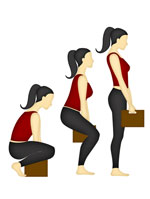
How You Can Avoid Lifting (Anything) With Your Back to Prevent Pain
Sherwin Nicholson | Updated July 15, 2025
Bad Habit #3: Lifting with your back muscles
Continued from Bad Habit #2: Leaning over
This is one of those common sense rules that we repeatedly break. It’s easy to break because for practically every 10 times you lift this way, you may only feel sore once. It WILL catch up with you. Maybe that is why you are on this page.
This is one of the most common ways people experience BACK SPASMS.
And as bad as it seems for you to suffer a back spasm when you lift this way, the actual spasm is a WARNING SIGN that there may be injury to either deeper back muscles or a lumbar disc.
Don’t ignore a spasm, it’s a normal reaction from your body to alert you that it’s trying to immobilize a weaker area that is prone to tissue injury. If the spasm is frequent, then you are experiencing a recurring injury that the spasm is trying to prevent.
Not Just One Time
It’s not just that one time that is the concern but lifting poorly has cumulative problems. If you were to combine excessive sitting, leaning too far along with poor lifting, you are going to suffer from it.
This is what you want to STOP doing to avoid falling into a nasty habit of doing.
 Lifting poorly involves using your back muscles to straight yourself up while using little leg power and flexibility.
Lifting poorly involves using your back muscles to straight yourself up while using little leg power and flexibility.
Lifting is pretty abusive for the spine and erector muscles
Here, your spine does more of the physical movement than any other part of the body. The lowest discs of your lumbar region are bearing the heaviest and most unbalanced load possible. You may either feel the immediate pain from a disc herniation or the chronic pain of disc degeneration and facet joint wear.
Remember. If you overexert a strained or neglected muscle, at some point the smaller and deeper muscles that are there to stabilize your spine will fatigue and hurt, causing the larger ones to spasm.
Here is how you should be lifting anything to avoid pain

- First be sure to avoid Bad Habit #2: Leaning too much. This is the first step.
- Use your legs only to lower yourself while keeping your posture vertical.
- Don’t worry too much about keeping a perfect neutral curve. As long as you are not hunched or over arching, you should be fine.
- Rely on squatting evenly or use the reverse lunge to activate your glutes
- Contract your abdominals and squeeze your butt muscles.
- Bring yourself to the object. Not the other way around. Keep it close to your body.
- Raise up slowly by using ONLY your leg muscles. Focus on contracting your butt (gluteus) muscles.
- Stay vertical and don’t hunch or lean backwards.
Rule of Thumb: Let your legs do ALL of the work
If you are using the power of your upper body more than your lower, you will injure yourself.
We are all guilty of this but this solution is simple and costs nothing to do.
Even after you spend your time and money with professionals and specialists to help you relieve discomfort, they will teach you this very same rule.
Find the hidden opportunities of proper lifting
When people lift poorly, they are not taking advantage of the opportunity to use the movement as a time to exercise. They may see it as a chore instead, so it has less relevance to them.
If you look at some of your chores as an opportunity to become more fit, you’ll likely do it carefully and more often.
Even when I am performing the most mundane chore (that I have no choice but to do), I try to make it into a reason to retrain and recondition my muscles. Eventually it becomes the preferred way that I want to lift.
Bad habits shouldn’t cost anything to break.
Next: Bad Habit #4 you must stop
Previous: Bad Habit #2: Leaning over
More help for your pain:
Strengthen your glutes to lift better
